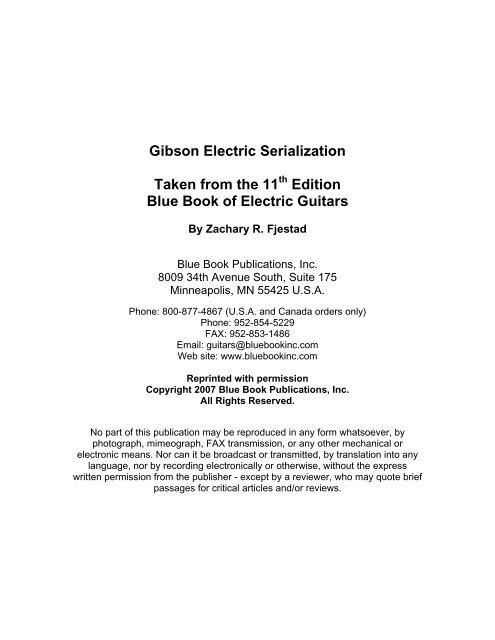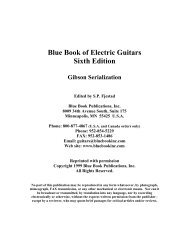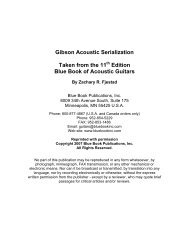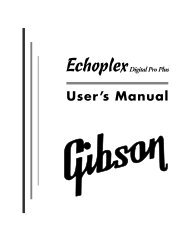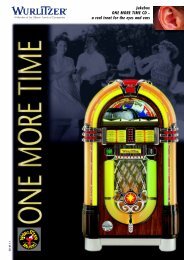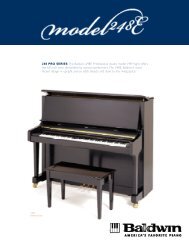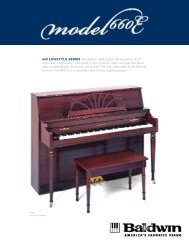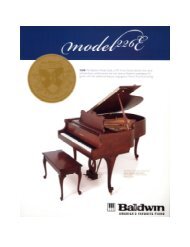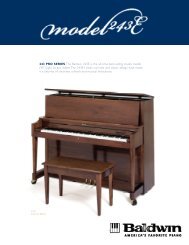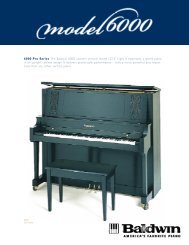Gibson Electric Serialization Taken from the 11 Edition Blue Book of ...
Gibson Electric Serialization Taken from the 11 Edition Blue Book of ...
Gibson Electric Serialization Taken from the 11 Edition Blue Book of ...
Create successful ePaper yourself
Turn your PDF publications into a flip-book with our unique Google optimized e-Paper software.
<strong>Gibson</strong> <strong>Electric</strong> <strong>Serialization</strong><br />
<strong>Taken</strong> <strong>from</strong> <strong>the</strong> <strong>11</strong> th <strong>Edition</strong><br />
<strong>Blue</strong> <strong>Book</strong> <strong>of</strong> <strong>Electric</strong> Guitars<br />
By Zachary R. Fjestad<br />
<strong>Blue</strong> <strong>Book</strong> Publications, Inc.<br />
8009 34th Avenue South, Suite 175<br />
Minneapolis, MN 55425 U.S.A.<br />
Phone: 800-877-4867 (U.S.A. and Canada orders only)<br />
Phone: 952-854-5229<br />
FAX: 952-853-1486<br />
Email: guitars@bluebookinc.com<br />
Web site: www.bluebookinc.com<br />
Reprinted with permission<br />
Copyright 2007 <strong>Blue</strong> <strong>Book</strong> Publications, Inc.<br />
All Rights Reserved.<br />
No part <strong>of</strong> this publication may be reproduced in any form whatsoever, by<br />
photograph, mimeograph, FAX transmission, or any o<strong>the</strong>r mechanical or<br />
electronic means. Nor can it be broadcast or transmitted, by translation into any<br />
language, nor by recording electronically or o<strong>the</strong>rwise, without <strong>the</strong> express<br />
written permission <strong>from</strong> <strong>the</strong> publisher - except by a reviewer, who may quote brief<br />
passages for critical articles and/or reviews.
GIBSON<br />
GIBSON<br />
GIBSON ELECTRIC<br />
ELECTRIC<br />
SERIALIZATION,<br />
SERIALIZATION<br />
cont.<br />
Identifying <strong>Gibson</strong> instruments by serial number is tricky at best, and<br />
downright impossible in some cases. The best method <strong>of</strong> identifying <strong>the</strong>m<br />
is to use a combination <strong>of</strong> <strong>the</strong> serial number, <strong>the</strong> factory order number and<br />
any features that are particular to a specific time. (i.e. logo design change,<br />
headstock volutes, etc).<br />
In addition to <strong>the</strong> above serial number information, <strong>Gibson</strong> also used<br />
Factory Order Numbers (F O N) to track batches <strong>of</strong> instruments being<br />
produced at <strong>the</strong> time. In <strong>the</strong> earlier years at <strong>Gibson</strong>, guitars were normally<br />
built in batches <strong>of</strong> forty instruments. <strong>Gibson</strong>’s Factory Order<br />
Numbers were an internal coding that followed <strong>the</strong> group <strong>of</strong> instruments<br />
through <strong>the</strong> factory. Thus, <strong>the</strong> older <strong>Gibson</strong> guitars may have a<br />
serial number and a F O N. The F O N may indicate <strong>the</strong> year, batch<br />
number, and <strong>the</strong> ranking (order <strong>of</strong> production within <strong>the</strong> batch <strong>of</strong><br />
forty).<br />
This system is useful in helping to date and au<strong>the</strong>nticate instruments.<br />
There are three separate groupings <strong>of</strong> numbers that have been identified<br />
and which are used for <strong>the</strong>ir accuracy. The numbers are usually stamped or<br />
written on <strong>the</strong> instrument’s back and seen through <strong>the</strong> lower f-hole or<br />
round soundhole, or maybe impressed on <strong>the</strong> back <strong>of</strong> <strong>the</strong> headstock.<br />
Code Letter F O Ns were discontinued after 1941, and any instruments<br />
made during or right after World War II do not bear an F O N codes. In<br />
1949, a four digit F O N was used, but not in conjunction with any code<br />
letter indicating <strong>the</strong> year.<br />
From 1952-1961, <strong>the</strong> F O N scheme followed <strong>the</strong> pattern <strong>of</strong> a letter, <strong>the</strong><br />
batch number, and an instrument ranking number (when <strong>the</strong> guitar was<br />
built in <strong>the</strong> run <strong>of</strong> forty). The F O N is <strong>the</strong> only identification number on<br />
<strong>Gibson</strong>’s lower grade models (like <strong>the</strong> ES-125, ES-140, J-160E, etc.)<br />
which do not feature a paper label. Higher grade models (such as <strong>the</strong><br />
Super 400, L-5, J-200, etc.) feature both a serial number and a FON.<br />
When both numbers are present on a higher grade model, remember that<br />
<strong>the</strong> FON was assigned at <strong>the</strong> beginning <strong>of</strong> <strong>the</strong> production run, while <strong>the</strong><br />
serial number was recorded later (before shipping). The serial number<br />
would properly indicate <strong>the</strong> actual date <strong>of</strong> <strong>the</strong> guitar.<br />
1935-1947: The first production electric guitars appeared in 1935. These<br />
guitars picked up on <strong>the</strong> serialization, which was already established by <strong>the</strong><br />
acoustic models. The serial numbers started with number 100 for acoustics<br />
and around 90000 for electrics. This system ran to 99999 for both<br />
acoustics and electrics. All numbers are approximate. In most cases, only<br />
<strong>the</strong> upper end instruments were assigned identification numbers. Serial<br />
numbers appear ink-stamped on a white paper label. FONs were first used<br />
in 1935. O<strong>the</strong>r FONs may appear that aren’t listed here that were produced<br />
during WWII. From 1935 to 1937, <strong>the</strong> letter appeared between <strong>the</strong><br />
batch and instrument numbers (i.e. 722 A 23, 465 D 58, 863 E 02). The<br />
number is ink-stamped inside <strong>the</strong> guitar on <strong>the</strong> back. In 1938, <strong>the</strong> FON<br />
was changed to a two- or three-letter prefix before <strong>the</strong> batch and instrument<br />
numbers. The first letter indicates <strong>the</strong> year, <strong>the</strong> second indicates <strong>the</strong><br />
brand (i.e. G for <strong>Gibson</strong>, K for Kalamazoo), and <strong>the</strong> third (if applicable)<br />
for electric. The FON is ei<strong>the</strong>r ink-stamped on <strong>the</strong> label or on <strong>the</strong> back <strong>of</strong><br />
<strong>the</strong> headstock.<br />
SERIAL NUMBERS<br />
APPROX. LAST NUMBER YEAR<br />
92800 1935<br />
94100 1936<br />
95200 1937<br />
95750 1938<br />
96050 1939<br />
96600 1940<br />
97400 1941<br />
97700 1942<br />
97850 1943<br />
98250 1944<br />
98650 1945<br />
99300 1946<br />
99999 1947<br />
FACTORY ORDER NUMBERS (FON)<br />
LETTER YEAR<br />
A 1935<br />
B 1936<br />
C 1937<br />
D 1938<br />
DA 1938<br />
E(X, OR OTHER LETTERS) 1939<br />
GIBSON ELECTRIC SERIALIZATION 1<br />
FACTORY ORDER NUMBERS (FON)<br />
LETTER YEAR<br />
E 1941<br />
F 1940<br />
FA 1940<br />
G 1941<br />
H 1942<br />
1947-1961 (HOLLOWBODIES): <strong>Gibson</strong> changed <strong>the</strong>ir serialization system<br />
once <strong>the</strong>y reached 99999 and decided <strong>the</strong>y did not want to go to a<br />
six-digit system. Instead, <strong>the</strong>y added an A prefix followed by a three-, four-<br />
, or five-digit number. The new system started on April 28, 1947 with<br />
number A 100. The last number was used on February 21, 1961. From<br />
1947 to early 1955, white oval labels were used. In early 1955, <strong>the</strong> label<br />
was changed to an orange oval. Serial numbers are on <strong>the</strong> label and FONs<br />
are ink-stamped on <strong>the</strong> inside back <strong>of</strong> <strong>the</strong> guitar. FONs consisted <strong>of</strong> a letter,<br />
four-digit batch number, and count number (i.e. Y 2230 21, V 4867<br />
8, R 6785 15). FONs were discontinued after <strong>Gibson</strong> changed to <strong>the</strong> new<br />
serialization system in 1961.<br />
SERIAL NUMBERS<br />
APPROX. LAST NUMBER YEAR<br />
A 1304 1947<br />
A 2665 1948<br />
A 4413 1949<br />
A 6597 1950<br />
A 9419 1951<br />
A 12462 1952<br />
A 16101 1953<br />
A 18667 1954<br />
APPROX. LAST NUMBER YEAR<br />
A 21909 1955<br />
A 24755 1956<br />
A 26819 1957<br />
A 28880 1958<br />
A 32284 1959<br />
A 35645 1960<br />
A 36147 1961<br />
700-1000S 1947<br />
<strong>11</strong>00-3700S 1948<br />
FACTORY ORDER NUMBERS (FON)<br />
LETTER/NUMBER YEAR<br />
3700-4500S EARLY 1949<br />
2000S LATE 1949<br />
3000-5000S 1950<br />
6000-9000S 1951<br />
Z 1952<br />
Y 1953<br />
X 1954<br />
W 1955<br />
V 1956<br />
U 1957<br />
T 1958<br />
S 1959<br />
R 1960<br />
Q 1961<br />
1952-1961 (SOLIDBODIES): When production <strong>of</strong> solidbody guitars<br />
began, an entirely new serial number system was developed. Though not<br />
used on <strong>the</strong> earliest instruments produced (those done in 1952), a few <strong>of</strong><br />
<strong>the</strong>se instruments have three digits stamped on <strong>the</strong> headstock top. Sometime<br />
in 1953, instruments were ink stamped on <strong>the</strong> headstock back with<br />
5- or 6-digit numbers, <strong>the</strong> first digit indicating <strong>the</strong> year, and <strong>the</strong> following<br />
digits indicating production numbers (Y NNNN or Y NNNNN). The<br />
production numbers run in a consecutive order and, aside <strong>from</strong> a few oddities<br />
in <strong>the</strong> change over years (1961-1962), it is fairly accurate to use <strong>the</strong>m<br />
when identifying solid body instruments produced between 1953 and<br />
1961. Later models typically feature six-digit numbers. Examples <strong>of</strong> this<br />
system:<br />
4 2205 = 1954<br />
6 14562 = 1956<br />
0 9865 = 1960<br />
1961-1970: In 1961, <strong>Gibson</strong> started a new serial number system that cov-
2 GIBSON ELECTRIC SERIALIZATION, cont.<br />
ered all instrument lines. It consisted <strong>of</strong> numbers that were impressed into<br />
<strong>the</strong> wood. This is generally considered to be <strong>the</strong> most confusing out <strong>of</strong> all<br />
<strong>Gibson</strong>’s serial number systems used between <strong>the</strong> years 1961 and 1970.<br />
There are several instances where batches <strong>of</strong> numbers are switched in order<br />
and duplicated, not just once, but up to four times, and seem to be randomly<br />
assigned throughout <strong>the</strong> decade.<br />
Note: If "MADE IN USA" is stamped in <strong>the</strong> back <strong>of</strong> <strong>the</strong> headstock near<br />
<strong>the</strong> serial number, <strong>the</strong> guitar is not <strong>from</strong> <strong>the</strong> 1960s, but <strong>the</strong> 1970s. In this<br />
case, please refer to <strong>the</strong> next section on serializationf for 1970-1975 guitars.<br />
NUMBER YEAR<br />
100-42440 1961<br />
42441-6<strong>11</strong>80 1962<br />
61450-64222 1963<br />
64240-71040 1964<br />
71041-96600 1962, 1963, 1964<br />
96601-99999 1963<br />
000001-099999 1967<br />
100000-106099 1963, 1967<br />
106100-108999 1963<br />
109000-109999 1963, 1967<br />
<strong>11</strong>0000-<strong>11</strong>1549 1963<br />
<strong>11</strong>1550-<strong>11</strong>5799 1963, 1967<br />
<strong>11</strong>5800-<strong>11</strong>8299 1963<br />
<strong>11</strong>8300-120999 1963, 1967<br />
121000-139999 1963<br />
140000-140100 1963, 1967<br />
140101-144304 1963<br />
144305-144380 1963, 1964<br />
144381-149864 1963<br />
149865-149891 1964<br />
149892-152989 1963<br />
152990-174222 1964<br />
174223-176643 1964, 1965<br />
176644-250335 1964<br />
250336-305983 1965<br />
306000-310999 1965, 1967<br />
3<strong>11</strong>000-320149 1965<br />
320150-320699 1967<br />
320700-329179 1965<br />
329180-330199 1965, 1967<br />
330200-332240 1965, 1967, 1968<br />
332241-348092 1965<br />
348093-349100 1966<br />
349121-368638 1965<br />
368640-369890 1966<br />
370000-370999 1967<br />
380000-385309 1966<br />
390000-390998 1967<br />
400001-406666 1966<br />
406667-409670 1966, 1967, 1968<br />
409671-410900 1966<br />
410901-419999 No Entries<br />
420000-429193 1966<br />
500000-500999 1965, 1966,1968, 1969<br />
501009-501600 1965<br />
501601-501702 1968<br />
501703-502706 1965, 1968<br />
503010-503109 1968<br />
503405-520955 1965, 1968<br />
520956-530056 1968<br />
530061-530850 1966, 1968, 1969<br />
530851-530993 1968, 1969<br />
530994-539999 1969<br />
540000-540795 1966, 1969<br />
540796-545009 1969<br />
555000-556909 1966<br />
558012-567400 1969<br />
570087-570643 1966<br />
570645-570755 1966, 1967<br />
NUMBER YEAR<br />
570857-570964 1966<br />
580000-580080 1969<br />
580086-580999 1966, 1967, 1969<br />
600000-600998 1966, 1967, 1968 (LOW END)<br />
600000-606090 1969 (HIGH END)<br />
700000-700799 1966, 1967<br />
750000-750999 1968, 1969<br />
800000-800999 1966, 1967, 1968, 1969<br />
801000-812838 1966, 1969<br />
812900-819999 1969<br />
820000-820087 1966, 1969<br />
820088-823830 1966*<br />
824000-824999 1969<br />
828002-847488 1966, 1969<br />
847499-858999 1966, 1969<br />
859001-895038 1967<br />
895039-896999 1968<br />
897000-898999 1967, 1969<br />
899000-899999 1968<br />
900000-901999 1970<br />
910000-999999 1968<br />
1970-1975: From 1970 to 1975 <strong>the</strong> method <strong>of</strong> serializing instruments at<br />
<strong>Gibson</strong> became even more random. All numbers were impressed into <strong>the</strong><br />
wood and a six-digit number was assigned, though no particular order was<br />
given and some instruments had a letter prefix. The orange labels inside<br />
hollow bodied instruments were discontinued in 1970 and were replaced<br />
by white and orange rectangular labels on <strong>the</strong> acoustics, and small black,<br />
purple, and white rectangular labels were placed on electric models.<br />
In 1970, <strong>the</strong> words MADE IN USA were impressed into <strong>the</strong> back <strong>of</strong><br />
instrument headstocks (though a few instruments <strong>from</strong> <strong>the</strong> 1950s also had<br />
this. The difference between a 1960s and a 1970s <strong>Gibson</strong> model is <strong>the</strong><br />
"MADE IN USA" stamp on <strong>the</strong> back <strong>of</strong> <strong>the</strong> headstock.<br />
NUMBER YEAR<br />
000000S 1973<br />
100000S 1970-1975<br />
200000S 1973-1975<br />
300000S 1974-1975<br />
400000S 1974-1975<br />
500000S 1974-1975<br />
600000S 1970, 1971, 1972, 1974, 1975<br />
700000S 1970, 1971, 1972<br />
800000S 1973, 1974, 1975<br />
900000S 1970, 1971, 1972<br />
6 DIGITS + A 1970<br />
A + 6 DIGITS 1973, 1974, 1975<br />
B + 6 DIGITS 1974, 1975<br />
C + 6 DIGITS 1974, 1975<br />
D + 6 DIGITS 1974, 1975<br />
E + 6 DIGITS 1974, 1975<br />
F + 6 DIGITS 1974, 1975<br />
When <strong>the</strong> Nashville <strong>Gibson</strong> plant was opened in 1974, it was decided that<br />
<strong>the</strong> bulk <strong>of</strong> <strong>the</strong> production <strong>of</strong> products would be run in <strong>the</strong> South; <strong>the</strong><br />
Kalamazoo plant would produce <strong>the</strong> higher end (fancier) models in <strong>the</strong><br />
North. Of course, many <strong>of</strong> <strong>the</strong> older guitar builders and craftsmen were<br />
still in Kalamazoo, and if <strong>the</strong>y weren’t ready to change how <strong>the</strong>y built guitars,<br />
<strong>the</strong>n <strong>the</strong>y may not have been ready to change how <strong>the</strong>y numbered<br />
<strong>the</strong>m! Certain guitar models built in <strong>the</strong> late 1970s can be used to demonstrate<br />
<strong>the</strong> old-style, six-digit serial numbers. It is estimated that <strong>Gibson</strong>’s<br />
Kalamazoo plant continued to use <strong>the</strong> six-digit serial numbers through<br />
1978 and 1979. So double check <strong>the</strong> serial numbers on those 1970s L-5s,<br />
Super 400s, and Super 5 BJBs!<br />
1975-1977: During <strong>the</strong> period <strong>from</strong> 1975 to 1977, <strong>Gibson</strong> used a transfer<br />
that had eight-digit numbers. The first two indicate <strong>the</strong> year (99=1975,<br />
00=1976 and 06=1977), <strong>the</strong> following six digits are in <strong>the</strong> 100000 to<br />
200000 range. MADE IN USA was also included on <strong>the</strong> transfer and some<br />
models had LIMITED EDITION also applied. A few bolt-on neck instruments<br />
had a date ink stamped on <strong>the</strong> heel area.<br />
NUMBER YEAR<br />
99XXXXXX 1975<br />
00XXXXXX 1976<br />
06XXXXXX 1977
1977-JUNE 2005: Between 1997 and late June or early July 2005, <strong>Gibson</strong><br />
used <strong>the</strong> same serialization system on all standard-built guitars. This<br />
updated system utilizes an impressed, eight-digit numbering scheme that<br />
covers both serializing and dating functions. The Custom/Historic/Art<br />
divisions do not use this system. Certain models in <strong>the</strong> Standard series also<br />
do not follow this, ei<strong>the</strong>r. Please refer to <strong>the</strong> end <strong>of</strong> <strong>the</strong> section for exceptions.<br />
The pattern is as follows:<br />
YDDDYPPP<br />
YY is <strong>the</strong> production year<br />
DDD is <strong>the</strong> day <strong>of</strong> <strong>the</strong> year<br />
PPP is <strong>the</strong> plant designation and/or instrument rank.<br />
In 1994, for <strong>Gibson</strong>’s Centennial, <strong>the</strong>y used a special serialization. Every<br />
serial number started with 94 followed by six digits, which were <strong>the</strong> production<br />
dates and number (YYNNNNNN).<br />
The three PPP numbers 001-499 indicate Kalamazoo production <strong>from</strong><br />
1977 to 1984. The Kalamazoo numbers were discontinued in 1984 when<br />
<strong>the</strong> factory closed. The three PPP numbers 500-999 indicate Nashville<br />
production <strong>from</strong> 1977 to 1989.<br />
All currently manufactured <strong>Gibson</strong>s (non-custom shop) are stamped with<br />
a hand arbor, and start at 300 or 500, and continue until production is<br />
finished that day. This hand stamp used to be reset daily at #300 or #500<br />
for all <strong>the</strong> LP style headstocks. The o<strong>the</strong>r shapes (Flying V, T-Bird,<br />
Explorer, etc.) were started at 700.<br />
When acoustic production began at <strong>the</strong> plant in Bozeman, Montana (in<br />
1989), <strong>the</strong> series’ numbers were reorganized. Bozeman instruments began<br />
using 001-299 designations and, in 1990, Nashville instruments began<br />
using 300-999 designations. It should also be noted that <strong>the</strong> Nashville<br />
plant has not reached <strong>the</strong> 900s since 1977, so <strong>the</strong>se numbers have been<br />
reserved for prototypes. Examples:<br />
70108276 means <strong>the</strong> instrument was produced on Jan. 10, 1978, in<br />
Kalamazoo and was <strong>the</strong> 276th instrument stamped that day.<br />
82765501 means <strong>the</strong> instrument was produced on Oct. 3, 1985, in Nashville<br />
and was <strong>the</strong> 1st instrument stamped that day.<br />
03202652 means <strong>the</strong> instrument was produced on November 16, 2002<br />
and was <strong>the</strong> 152nd instrument stamped that day (assuming <strong>the</strong>y started at<br />
500).<br />
There are a few exceptions to this system.<br />
JULY 2005-PRESENT: In early July 2005, <strong>Gibson</strong> altered <strong>the</strong>ir serialization<br />
system a bit. A modified nine digit system was introduced with a new<br />
batch number added to <strong>the</strong> previous system. The new system follows <strong>the</strong><br />
format <strong>of</strong> YDDDYBPPP. The first through fifth digits and <strong>the</strong> seventh<br />
through ninth digits all follow <strong>the</strong> old system, but a batch number was<br />
implemeted to better keep track <strong>of</strong> production and allow for more than<br />
five hundred instruments to be produced in a day. At <strong>the</strong> beginning <strong>of</strong><br />
each day, <strong>the</strong> sixth digit is reset to 0. Once <strong>the</strong> last three numbers reach<br />
699, <strong>the</strong> batch number moves on to 1, and <strong>the</strong> last three digits are reset to<br />
500. Examples: 028360612 indicates a guitar that was stamped on <strong>the</strong><br />
283rd day (October 10th) in 2006 and was <strong>the</strong> <strong>11</strong>2th guitar stamped that<br />
day. 001071520 indicates a guitar that was stamped on <strong>the</strong> 10th day (January<br />
10th) <strong>of</strong> 2007 and was <strong>the</strong> 220th guitar stamped on that day (it was<br />
part <strong>of</strong> <strong>the</strong> second batch and <strong>the</strong> 20th guitar <strong>of</strong> <strong>the</strong> second batch - first<br />
batch was <strong>of</strong> 200 guitars).<br />
Centennial Year/Models: 1994 is <strong>the</strong> most notable exception, with <strong>the</strong> first<br />
two numbers representing <strong>the</strong> year, so all models start with 94 and are followed<br />
by six digits. The Centennial models produced for <strong>the</strong> 1994 model year have<br />
an inked-on serial number that is six digits long. The serial number appears as<br />
YYYYMM. The first four represent <strong>the</strong> number produced. They all started on<br />
1894, which represents instrument #1, and 1994 would be instrument #101.<br />
The last two digits indicate <strong>the</strong> month <strong>of</strong> <strong>the</strong> guitar released. A new model was<br />
released each month with a total <strong>of</strong> fourteen different models that includes two<br />
prototypes. The last two numbers will range <strong>from</strong> one to fourteen.<br />
Special Runs/Limited <strong>Edition</strong>s: Certain special editions in <strong>the</strong> 1970s and<br />
1980s may feature serial numbers with six digits in <strong>the</strong> configuration <strong>of</strong><br />
YY NNNN. The YY indicates <strong>the</strong> year and <strong>the</strong> NNNN is <strong>the</strong> instrument<br />
ranking.<br />
Les Paul Classic: The 1960 Les Paul Classic features a six-digit number<br />
like <strong>the</strong> models had in <strong>the</strong> late 1950s and early 1960s. The serial number<br />
works just like it did back <strong>the</strong>n with <strong>the</strong> first number indicating <strong>the</strong> last<br />
number in <strong>the</strong> year <strong>of</strong> production. The following four or five digits are<br />
production rank and if <strong>the</strong>re is only four digits <strong>the</strong>re will be a space<br />
between <strong>the</strong> first and last four digits, but if <strong>the</strong>re are five digits <strong>the</strong>y will all<br />
appear toge<strong>the</strong>r. For example, 215678 would be ei<strong>the</strong>r a 1992 or 2002,<br />
GIBSON ELECTRIC SERIALIZATION, cont. 3<br />
and a 615890 would be a 1996. These models have been produced since<br />
1990, so every ten years <strong>the</strong> numbers will recycle. Also, in 1989 only, a<br />
four digit number was first used that started with 9. No "Made In U.S.A."<br />
stamp appears by <strong>the</strong> serial number ei<strong>the</strong>r.<br />
CUSTOM SHOP: Regular production Custom Shop guitars utilize a<br />
serialization system <strong>of</strong> CSYRRRR. CS stands for Custom Shop, <strong>the</strong> Y<br />
indicates <strong>the</strong> last digit in <strong>the</strong> year <strong>of</strong> production, and <strong>the</strong> following digits<br />
indicate <strong>the</strong> production ranking. Earlier Custom Shop models may use a<br />
Y9NNN or Y9NNNN (if <strong>the</strong> production run is higher than 1000 units in<br />
a year). The Y indicates <strong>the</strong> last digit <strong>of</strong> <strong>the</strong> year <strong>the</strong> guitar was built. 9 is<br />
assigned to every custom shop guitar, and <strong>the</strong> last three or four digits are<br />
production numbers. Example: CS31205 is a Custom Shop instrument<br />
produced in 2003 and was <strong>the</strong> 1,205th guitar built that year.<br />
Reissues: Early Les Paul reissues produced between <strong>the</strong> late 1970s and 1993<br />
should have an inked-on serial number on <strong>the</strong> back <strong>of</strong> <strong>the</strong> headstock. The first<br />
number should indicate <strong>the</strong> last year <strong>of</strong> <strong>the</strong> production. For example, 8 0358<br />
would be a 1988. The Heritage Flying V, Moderne, and Chet Atkins CE produced<br />
between 1981 and 1983 will feature a serial number with a letter prefix<br />
followed by three digits. The letter may range <strong>from</strong> A through K, and <strong>the</strong> number<br />
started at 001. Most numbers finished at 099 and would move to <strong>the</strong> next<br />
letter. However, certain models do feature higher numbers than 100. The Heritage<br />
Series Explorer produced between 1982 and 1983 has a serial number that<br />
starts with 1 + 4 digits. These digits are strictly production numbers.<br />
In 1992, <strong>the</strong> serialization <strong>of</strong> reissues became standard. The configuration<br />
<strong>of</strong> M YNNN is still in use by <strong>Gibson</strong>. The M indicates <strong>the</strong> model code,<br />
specifically <strong>the</strong> last digit <strong>of</strong> <strong>the</strong> year <strong>of</strong> <strong>the</strong> reissue. The Y indicates <strong>the</strong> last<br />
number <strong>of</strong> <strong>the</strong> year <strong>of</strong> <strong>the</strong> guitar, and <strong>the</strong> NNN are <strong>the</strong> production numbers.<br />
For example, 4 8256 indicates a 1954 Les Paul reissue built in 1998<br />
and is <strong>the</strong> 256th instrument <strong>of</strong> <strong>the</strong> year. The following codes represent<br />
most <strong>of</strong> <strong>the</strong> reissues:<br />
NUMBER MODELS<br />
2 1952 LES PAUL<br />
4 1954 LES PAUL<br />
6 1956 LES PAUL<br />
NUMBER MODELS<br />
7 1957 LES PAUL<br />
8 1958 LES PAUL, EXPLORER<br />
9 1959 LES PAUL, FLYING V<br />
0 1960 LES PAUL<br />
In 1997, <strong>Gibson</strong> reissued many <strong>of</strong> <strong>the</strong> 1960s models. A similar serialization<br />
system was used, but it is different than <strong>the</strong> 1950s reissues. The configuration<br />
consists <strong>of</strong> YYNNNM, where <strong>the</strong> YY is <strong>the</strong> last two years <strong>of</strong> <strong>the</strong><br />
guitar’s construction date, <strong>the</strong> NNN is <strong>the</strong> production number, and <strong>the</strong> M<br />
is <strong>the</strong> model code, specifically <strong>the</strong> last year <strong>of</strong> <strong>the</strong> reissue. For example,<br />
021568 indicates a 1968 Les Paul Custom reissue built in 2002 and was<br />
<strong>the</strong> 156th instrument built that year. The following codes represent most<br />
<strong>of</strong> <strong>the</strong> reissues:<br />
NUMBER MODELS<br />
1 SG CUSTOM/SG SPECIAL/LES PAUL<br />
2 SG STANDARD<br />
3 1963 FIREBIRD I<br />
4 1964 FIREBIRD III<br />
5 1965 FIREBIRD V/FIREBIRD VII<br />
8 1968 LES PAUL CUSTOM<br />
HISTORIC ES MODELS: Historic ES models use a slightly different<br />
system than <strong>the</strong> Custom Shop. The configuration consists <strong>of</strong> a letter prefix<br />
+ MYNNN. The letter, which is usually an A or B, indicates that it is part<br />
<strong>of</strong> <strong>the</strong> Historic Collection, <strong>the</strong> M indicates <strong>the</strong> last year <strong>of</strong> reissue model,<br />
<strong>the</strong> Y indicates <strong>the</strong> last number <strong>of</strong> <strong>the</strong> year <strong>the</strong> guitar was built, and <strong>the</strong><br />
final NNN digits are production numbers. For example, A-93012 is a<br />
2003 1959 ES-335 with Dot inlays reissue and it was <strong>the</strong> 12th instrument<br />
produced that year.The following codes represent most <strong>of</strong> <strong>the</strong> reissues:<br />
NUMBER MODELS<br />
2 ES-295<br />
3 1963 ES-335 BLOCK INLAYS<br />
4 ES-330<br />
5 ES-345<br />
9 W/ A PREFIX 1959 ES-335 DOT INLAYS<br />
9 W/ B PREFIX ES-355<br />
CARVED TOP MODELS: On models with carved or ached tops <strong>the</strong><br />
number will normally appear on an orange label. The serialization used on<br />
<strong>the</strong>se instruments consists <strong>of</strong> a format YDDDYRRR, which is very similar<br />
to <strong>Gibson</strong>’s standard serialization system. The first and fith digits indicate
4 GIBSON ELECTRIC SERIALIZATION, cont.<br />
<strong>the</strong> last two years, <strong>the</strong> second, third, and fourth indicate <strong>the</strong> day <strong>of</strong> <strong>the</strong><br />
year according to <strong>the</strong> Julian calendar, and <strong>the</strong> final three digits indicate <strong>the</strong><br />
numbering sequence <strong>of</strong> carved/arched top instruments produced that day.<br />
In 2000, <strong>Gibson</strong> changed this system so every serial number starts with 2<br />
instead <strong>of</strong> 0. Examples: 21364003 indicates a guitar stamped on <strong>the</strong> 136th<br />
day (May 16th) <strong>of</strong> 2004 and was <strong>the</strong> 3rd carved top model stamped that<br />
day.<br />
CUSTOM SHOP SIGNATURE MODELS: Most Custom Shop signature<br />
guitars use a serialization system with <strong>the</strong> artists initials and <strong>the</strong><br />
instrument production number.<br />
The <strong>Gibson</strong> Les Paul Chambered Reissue (also known as <strong>the</strong> Cloud Nine)<br />
has a "CR" prefix before <strong>the</strong> serial number. This model was introduced in<br />
2004.<br />
Source: A.R. Duchossoir, <strong>Gibson</strong> <strong>Electric</strong>s, The Classic Years and<br />
Walter Carter and George Gruhn, Gruhn’s Guide to Vintage Guitars.


